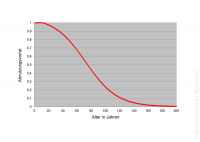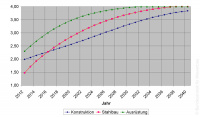Condition forecast: Difference between revisions
From BAWiki
No edit summary |
No edit summary |
||
| Line 3: | Line 3: | ||
The ageing process undergone by steel structures differs from that observed in solid structures or equipment. It is therefore necessary to obtain different ageing functions. To define the parameters of the functions, the Project Group Asset Management System conducted a Delphi interview. Based on this Delphi interview it was possible to systematically collect the expert knowledge available at the WSV and the BAW. As a result, ageing functions were obtained for different types of components in hydraulic structures. These functions can now be used to assess the current and future sub-ratings of the different components depending on their respective age, if no knowledge on damages is available. | The ageing process undergone by steel structures differs from that observed in solid structures or equipment. It is therefore necessary to obtain different ageing functions. To define the parameters of the functions, the Project Group Asset Management System conducted a Delphi interview. Based on this Delphi interview it was possible to systematically collect the expert knowledge available at the WSV and the BAW. As a result, ageing functions were obtained for different types of components in hydraulic structures. These functions can now be used to assess the current and future sub-ratings of the different components depending on their respective age, if no knowledge on damages is available. | ||
A failure rate can be derived from the ageing function which can be used to define a Markov matrix. The Markov matrix describes the probability whether, for a specific time increment, a damage is assigned to another damage category (damage is getting worse) or whether it remains within the same category. The method is highly suitable for forecasting the progress of recognized damages. The BAW has defined 14 deterioration processes for describing the substantial damages occurring in waterway structures. | |||
By combining the two methods it is possible to forecast how a structure's condition will change in the future, taking account of recognized damages and the effects ageing has on undamaged components. The sub-ratings of the different types of components which are obtained from structural inspection are used as the initial value for the current year. Figure 2 shows the evolution of the sub-ratings for a solid structure, steel structure and equipment starting from the initial values. | [[File:14_Zustand_Prognose_02.jpg|200px|thumb|right|Picture 2: Condition forecast of subsections of a single construction]]By combining the two methods it is possible to forecast how a structure's condition will change in the future, taking account of recognized damages and the effects ageing has on undamaged components. The sub-ratings of the different types of components which are obtained from structural inspection are used as the initial value for the current year. Figure 2 shows the evolution of the sub-ratings for a solid structure, steel structure and equipment starting from the initial values. | ||
---- | ---- | ||
back to: [[Structural Engineering Methods]] | back to: [[Structural Engineering Methods]] | ||
Revision as of 08:42, 25 March 2022

In principle, each ageing structure is characterized by an ageing curve that describes the change in condition over time. The Herz function, due to its flexibility, is particularly suitable for representing the ageing of infrastructure elements and their components. Figure 1 shows the curve of a Herz function with a resistance period at the beginning where no ageing effect is observed. The function also allows describing very old structures.
The ageing process undergone by steel structures differs from that observed in solid structures or equipment. It is therefore necessary to obtain different ageing functions. To define the parameters of the functions, the Project Group Asset Management System conducted a Delphi interview. Based on this Delphi interview it was possible to systematically collect the expert knowledge available at the WSV and the BAW. As a result, ageing functions were obtained for different types of components in hydraulic structures. These functions can now be used to assess the current and future sub-ratings of the different components depending on their respective age, if no knowledge on damages is available.
A failure rate can be derived from the ageing function which can be used to define a Markov matrix. The Markov matrix describes the probability whether, for a specific time increment, a damage is assigned to another damage category (damage is getting worse) or whether it remains within the same category. The method is highly suitable for forecasting the progress of recognized damages. The BAW has defined 14 deterioration processes for describing the substantial damages occurring in waterway structures.

By combining the two methods it is possible to forecast how a structure's condition will change in the future, taking account of recognized damages and the effects ageing has on undamaged components. The sub-ratings of the different types of components which are obtained from structural inspection are used as the initial value for the current year. Figure 2 shows the evolution of the sub-ratings for a solid structure, steel structure and equipment starting from the initial values.
back to: Structural Engineering Methods
